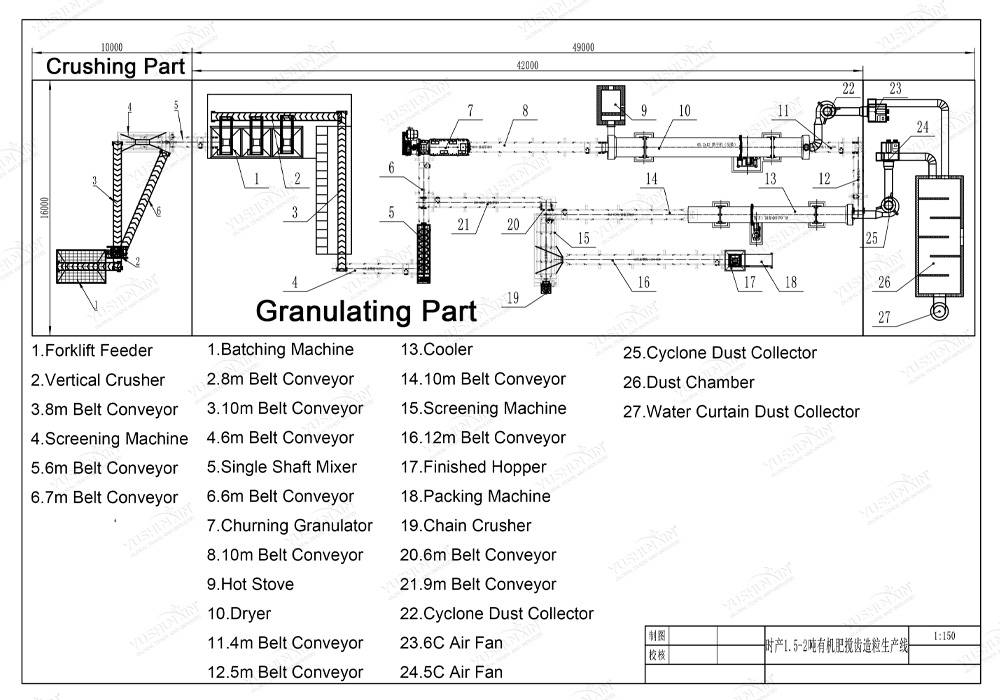







To convert phosphate rock into a usable fertilizer form, acid is required to “acidulate” the rock, which releases soluble phosphorus compounds. Common acids used include:
To create NPK fertilizers, other sources of nitrogen and potassium can be mixed with the phosphate material. Some examples include:
Omkostningerne ved hver produktionslinje varierer afhængigt af produktionskapacitet, grad af automatisering, og specifikke behov. Udfyld nedenstående formular, så giver vi dig et nøjagtigt tilbud!
Hvis du er interesseret i vores gødningsudstyr, Send venligst dine krav og kontakter, og så kontakter vi dig om to dage. Vi lover, at alle dine oplysninger ikke lækker til nogen.
- Virksomheden blev grundlagt i 2005 og har fokuseret på forskning og udvikling og fremstilling af organisk gødningsudstyr til 20 år. Det har bygget en 40.000 m stor skala organisk gødningsudstyrsproduktionsbase, ved hjælp af avanceret granulering, Tørring og screeningsteknologier for at forbedre produktionseffektiviteten og produktkvaliteten.
- En selvbetjent import- og eksportvirksomhed med mere end 80 Professionelle ingeniører over hele verden, tjener mere end 100 lande og regioner over hele verden, 5,000+ Kundeservicesager, 10 behandlingscentre, 3 Laserskæremaskiner, Og mere end 60 udstyr af forskellige typer.
- Opretholdelse af langsigtet og omfattende samarbejde med mange videnskabelige forskningsinstitutter og universiteter, with a professional R&D team, Det kan kontinuerligt optimere udstyrets ydeevne i henhold til markedets efterspørgsel.
- Høj styrke slidbestandige materialer, Carbon Steel Q235/Alloy er valgt for at sikre, at udstyret er holdbart og reducere vedligeholdelsesomkostninger.
- Vedtagelse af intelligente kontrolsystemer for at forbedre niveauet for produktionsautomation og reducere manuel afhængighed.
- ISO, Ce, SGS International Certification
- Med storskala produktionskapacitet, Det kan opfylde forskellige krav til produktionskapacitet (lille, mellemstore og store produktionslinjer).
- Et komplet udvalg af udstyrsmodeller, Velegnet til produktion af forskellige typer gødning, såsom organisk gødning, Forbindelsesgødning, Biologisk gødning, Vandopløselig gødning, flydende gødning, osv.
- Personligt design kan leveres i henhold til kundens behov, inklusive produktionskapacitet, Webstedslayout, Miljøbeskyttelsesstandarder, osv.
- Giv et komplet sæt produktionslinjeløsninger, inklusive valg af udstyr, installation og idriftsættelse, Teknisk træning, osv.

- Direkte fabriksforsyning, Reduktion af mellemmandens linje, Og prisen er mere konkurrencedygtig.
- Udstyret har høj energieffektivitet, reducerer energiforbruget, og hjælper kunder med at reducere langsigtede driftsomkostninger.
- Direkte fabriksforsyning, Reduktion af mellemmandens linje, Og prisen er mere konkurrencedygtig.
- Udstyret har høj energieffektivitet, reducerer energiforbruget, og hjælper kunder med at reducere langsigtede driftsomkostninger.
Levering af en gødningspoleringsmaskine til en førende gødningsproducent i Holland
Succesfuld levering af 1T/H dobbeltrullegranulatorer til kunder i Tyrkiet og Storbritannien
Effektiv kompostdrejningsløsning leveret til en filippinsk kunde
Succesfuld levering af en skivegranulator til en chilensk kunde til gødningsproduktion
Forøgelse af pelletiseringseffektivitet for GoodEarth Group, Sydafrika